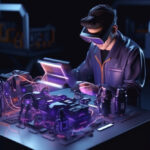7-Augmented Reality Ideas for Interactive Museum Experiences

The digital age has led us to lose or neglect many of our previous pleasures. Visiting museums was once a popular activity for kids as well as adults. A school excursion typically included a visit to a museum to view and be amazed by the world’s artistic, archaeological, and architectural wonders. Unfortunately, the allure of museums is fading as more readily available types of entertainment gain popularity. The smartphone has brought learning as well as entertainment to your fingertips. It is intriguing that we may be able to rely on the same digital technologies to restore museums’ lost aura.
Augmented reality is an exciting technology that allows us to overlay digital content onto the reality around us. We view this world using devices like smartphones, tablets, and uniquely designed goggles. Augmented reality delivers information and content that allows us to have a rich and engaging experience with the real world around us. This type of interactive experience helps us better understand and appreciate what we see. If you’ve ever played Pokemon Go on your smartphone, you’re probably familiar with augmented reality applications. Several more useful applications have been developed to assist people with their daily tasks. Every day, new applications that will improve people’s lives are being developed. Museums are no exception, with various AR solutions being used to make visitors’ experiences more interactive, engaging, and memorable.
Here are seven ideas for integrating augmented reality in museums to improve visitors’ experiences. Please evaluate these ideas and include them in your interactions with museum stakeholders about future augmented reality projects.
Idea number one! Visitors to museums can access information using their own smartphones.
Most traditional museums feature a collection of artifacts and paintings with little or no information about them. Any visitor passing by artifacts may be fortunate to notice a name on it. A museum guide could provide further information on the important artifacts, but a museum includes thousands of exhibits that may be impossible for anyone to recollect and provide details about. Museums can work with augmented reality solution providers to create applications that provide interactive content about each artifact just by scanning the QR code next to it. The content might be either plain text or an audio description of the artifact. It may also generate a video on the artifact.
Idea number two! Augmented reality can be used to show more detail about any artifact utilizing 3D models.
A sculpture, for example, could only be viewed from the front. In most cases, it has been enclosed in a glass case, preventing the observer from seeing the remaining sides. This deprives any visitor of a complete view of the artifact while revealing significant aspects of it. AR comes to the rescue by displaying a highly realistic 3D model of the artifact on your smartphone, allowing the viewer to rotate and flip it to see it from all angles.
It may also allow you to zoom in for a more detailed view, as well as an exploded or even x-ray image to reveal its internal structure and construction.
Idea number three! Enjoy the museum with your custom-made tour guide.
Anyone who visits popular museums will find museum guides willing to show them around and offer their knowledge of the objects on display. In some instances, the tour may not be of interest or appeal to you. Augmented reality can let you create a tour based on your preferences and give information as a virtual personal guide. The application would lead you through the museum using audio and visual content on your smartphone. This allows you to not only focus on the sites you want to explore while also making the best use of your valuable time that day. The app would provide pre-designed tours from which you could choose or create your own.
Idea number four! Engage youngsters in games.
Treasure hunting is one of the most popular museum activities. The goal is to find a set of artifacts in various regions of the museum, with clues leading to the final treasure. Teams or individuals would need to finish this activity within a set time frame. The augmented reality application allows the visitor to travel and discover clues that will finally lead them to the treasure. This is just one example; there might be many more games designed to make the whole museum visit more exciting and memorable.
Idea number five! Create learning places at museums.
Teaching history or science in the classroom would be simple for many teachers, but they may not always attain the appropriate level of comprehension and knowledge retention. A museum-based learning practice can help pupils learn a lot. Students view, touch, and feel artifacts that leave a lasting effect on their minds. Augmented reality-powered learning applications can be designed to meet specific learning objectives that children can attain during a museum tour.
Idea number six! Make your own personalized memorabilia for posterity.
Augmented reality can be used to consist of your image holding an artifact or standing next to another, even if they are enclosed and inaccessible. These could be selfies of great leaders, both dead and alive, produced using augmented reality. These images could be shared on social media for the pleasure of individuals in the visitor’s community. A simple visit to the Amma Museum in Chennai would serve as a good example of this use case.
Idea number seven! Let the world around you come to life!
Using developed solutions and a high-quality smartphone, the world around you comes to life with digital objects, artifacts, and even creatures. The smartphone pans around, and you see these objects appear and interact with you. An augmented reality exhibit in Singapore brings the fauna and flora of a rainforest to life, allowing visitors to see the wonderful creatures that often live there. Such experiences immerse visitors in an incredible atmosphere, providing an amazing experience within the augmented reality experience centre.
These are seven amazing augmented reality use cases that provide an interactive museum experience. Creating such experiences requires a thorough grasp of what museums seek and collaboration with key stakeholders within the museum organization from the beginning to the end of an AR project. Solution providers must have technical, artistic, construction, and, most significantly, project management competence to design, develop, and execute such projects. To generate such experiences, solution providers must have cross-functional expertise within the organisation. Fusion VR is certainly a pioneer in providing such experiences. A visit to our Museums and Corporate Experience Centres website will demonstrate the breadth of our knowledge and contributions to the industry. The website also has important information that will help you learn more about augmented reality and other innovative technologies that improve visitor experiences in museums. Our goal has always been to extend the use of AR in museums and improve the quality of the experience.

The To Tech Award 2024: The City That Produces the Revolutionaries of Tech

The Financial Side of Moving: Budgeting and Saving Tips

Making Memories: International Rakhi Celebrations and Traditions

Pre-Requisites Before Applying for an Instant Personal Loan

Embrace the Magic of Turkey: An Unforgettable Visit

Step-by-Step Guide to SAP Brownfield Migration

How to Summarize a Report Accurately in Seconds

Project Management and Accounting in Dynamics 365








